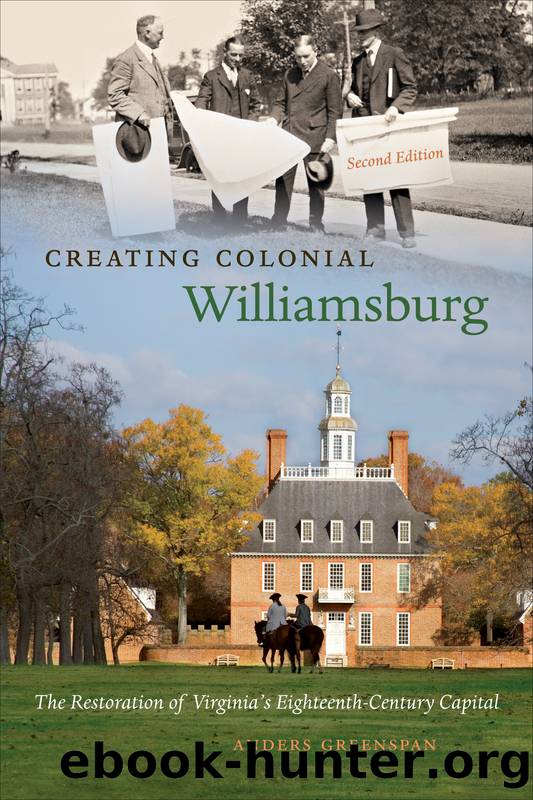Creating Colonial Williamsburg by Anders Greenspan

Author:Anders Greenspan
Language: eng
Format: epub
Publisher: The University of North Carolina Press
Published: 2020-08-15T00:00:00+00:00
A postwar couple views the front of the Raleigh Tavern with a guide in colonial dress, ca. 1955 (Courtesy of the Colonial Williamsburg Foundation)
Because Colonial Williamsburg exuded this democratic air, Boorstin felt that the restoration served as an excellent example of American political ideology. In stressing the continuity of the past and present in American culture, Colonial Williamsburg served as âan American kind of sacred document.â Although finding much to praise in the restoration effort, Boorstin found a few points to criticize as well: the tendency to overhomogenize the past and the temptation to make it too pretty and too relevant. No doubt, Colonial Williamsburg was guilty on these points. In attempting to create a perfect vision of the past, the restoration had sacrificed historic reality.57
Yet, as Boorstin argued, the tendency of Americans to re-create their past is understandable, since few historic relics remain. Due to the townâs development over the years, much of the historic area in Williamsburg actually had to be reconstructed, not merely restored, thereby creating a false image of the eighteenth century. The restoration tended to de-emphasize the fact that most of the structures that visitors saw were, in fact, re-creations.58
In conclusion, Boorstin blandly criticized the American penchant for erasing the past just to improve it. Such was the case with Colonial Williamsburg. In re-creating the eighteenth century, the restorationâs founders sought to make the past better than it actually was. He argued that for a country that desires a model future, the United States is quick to deny any errors in its past. Thus, âa house is removed to make way for a road; it is reconstructed to fit in the modern improvements: the two-car garage, the television room, or the air-conditioning.â In this way, the nation need not be bothered by incongruities in its history. Rather, Colonial Williamsburg demonstrated how one could improve on the past and use it to sell an important message to a later generation of Americans who, just as they were ready to purchase the manifestations of modern consumerism, were equally prepared to âbuyâ a sanitized version of the American past.59
Yet the restorationâs pristine nature allowed it to be accepted and touted as an educational landmark precisely because it kept certain aspects of colonial life in abeyance. By keeping the Revolutionary era one of beautiful architecture, tree-lined streets, famous men, and quaint customs, the people of the twentieth century could not help but admire its attributes. Ultimately, Colonial Williamsburg filled a growing void in twentieth-century life. In its presentation of a culture lost in the rush for progress, industrial might, and material affluence, Colonial Williamsburg became a respite from the chores of daily living and the chance to wallow in the sanctity of the past. In Colonial Williamsburg, Americans could be proud of their countryâs past and hopeful for its future, knowing that what many Americans in the mid-twentieth century viewed as the countryâs principal qualities were being permanently enshrined by what many locals called the Rockefeller restoration.
The retirement of Kenneth Chorley in 1958 and the death of JDR Jr.
Download
This site does not store any files on its server. We only index and link to content provided by other sites. Please contact the content providers to delete copyright contents if any and email us, we'll remove relevant links or contents immediately.
Kathy Andrews Collection by Kathy Andrews(10554)
The remains of the day by Kazuo Ishiguro(7577)
Spare by Prince Harry The Duke of Sussex(4222)
Paper Towns by Green John(4178)
The Body: A Guide for Occupants by Bill Bryson(3816)
Be in a Treehouse by Pete Nelson(3234)
Harry Potter and the Goblet Of Fire by J.K. Rowling(3077)
Goodbye Paradise(2977)
Never by Ken Follett(2907)
Into Thin Air by Jon Krakauer(2711)
The Remains of the Day by Kazuo Ishiguro(2627)
The Genius of Japanese Carpentry by Azby Brown(2616)
The Cellar by Natasha Preston(2605)
Drawing Shortcuts: Developing Quick Drawing Skills Using Today's Technology by Leggitt Jim(2537)
120 Days of Sodom by Marquis de Sade(2446)
Architecture 101 by Nicole Bridge(2356)
Machine Learning at Scale with H2O by Gregory Keys | David Whiting(2317)
The Man Who Died Twice by Richard Osman(2308)
Industrial Automation from Scratch: A hands-on guide to using sensors, actuators, PLCs, HMIs, and SCADA to automate industrial processes by Olushola Akande(2127)
